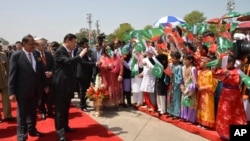China’s planned $46 billion in energy and infrastructure investments in Pakistan are aimed at transforming a country that has largely missed out on Asia’s rapid economic rise into a regional hub for trade and investment. There are risks for both, the ambitious investment projects and the mainly Chinese companies responsible for carrying them out.
China’s economy is slowing and as it does, the country is reaching into its deep pockets to expand its trade links to the rest of the world.
Earlier this month, Beijing launched a $100 billion infrastructure bank, attracting the support of some 56 other countries. China is also aggressively promoting a project it calls “The Belt and the Road,” aimed at boosting commerce to Africa, the Middle East, Central Asia and Europe. The plan will help build infrastructure like ports, roads and rail links across dozens of countries in an effort to boost local economies as well as China’s own.
China’s foreign investment
During President Xi Jinping’s visit to Pakistan this week, the two countries announced that a dam project in the northern part of the country will be the first recipient of money from the development effort’s investment fund.
Beijing has been ramping up overseas investment and foreign aid money over the past decade. But what is happening now is a turning point in how China is going to engage the world and Asia, said Scott Kennedy, director of the project on Chinese Business and Political Economy at the Center for Strategic and International Studies.
“We’re going to see the numbers grow dramatically over the next few years and the way in which this engagement occurs,” he said.
As the numbers rise, one big risk that China faces, analysts say, is keeping track of all that money. And that will be a big challenge for both countries, which have poor records when it comes to corruption.
Combating corruption
Shangri-La Dialogue Senior Fellow Alexander Neill said with so much riding on the plan, Beijing will be closely scrutinizing both the Chinese companies and their Pakistani counterparts to ensure money is being spent where it should be.
“Obviously the Chinese state is going to be monitoring its disbursement into these projects very closely,” Neill noted. “Not just in the light of Xi Jinping’s anti-corruption campaign, but also because they want to see any joint ventures or anything they do abroad as being water tight.”
Much of the massive investment for the “Belt and Road” and funds in Pakistan is widely expected to go to contracts won by Chinese enterprises, many of which lack experience in places such as Pakistan.
Scott Kennedy said that it should be expected that some of these investments could fail.
“[It] always looks good in the press release and the roll out events at the beginning, but the follow through is always much more challenging,” he said.
In recent years the United States allocated several billion dollars in foreign development assistance to Pakistan, but studies show that officials found it a significant challenge to responsibly disburse the funds. Security problems, corruption, the limited capacity of local partners, and natural disasters all made it difficult to spend the money as intended.
China: No strings attached
Chinese leaders have pointed out that their development assistance, unlike the United States, has “no political strings attached,” which means there will likely be significantly fewer regulations over who they partner with or how the funds are spent.
Some Chinese companies have been building up experience through their work in Afghanistan, bringing in their own private security. Beijing has also held talks with the Taliban as it navigates the delicate security environment there.
Alexander Neill said that may make it easier for Chinese companies to do business in Pakistan, but it does not remove all risks. “That is not to say that Chinese interests in Pakistan are not vulnerable. There have been several cases of Chinese nationals being kidnapped and executed,” he explained. “There have been attacks down in Baluchistan as well.”
Tom Miller, a senior analyst at Gavekal Dragonomics, said one individual close to President Xi told him that China is aware of the risks and sees engaging them as a critical part of their ambitious development plan.
“What he said to me was that, yes, there will be huge risks there, but China has to go to places like Pakistan if it really does want this region to be in its own backyard. As he said, if you have a backyard, you have to clean the corners,” Miller stated.
Just how smoothly that effort will go, remains to be seen. Most analysts agree that it is still too early to predict what kind of an impact the projects in Pakistan or elsewhere will have. They also say it is too early to tell whether Beijing will succeed in bringing countries around more tightly into its economic orbit or create a backlash.









